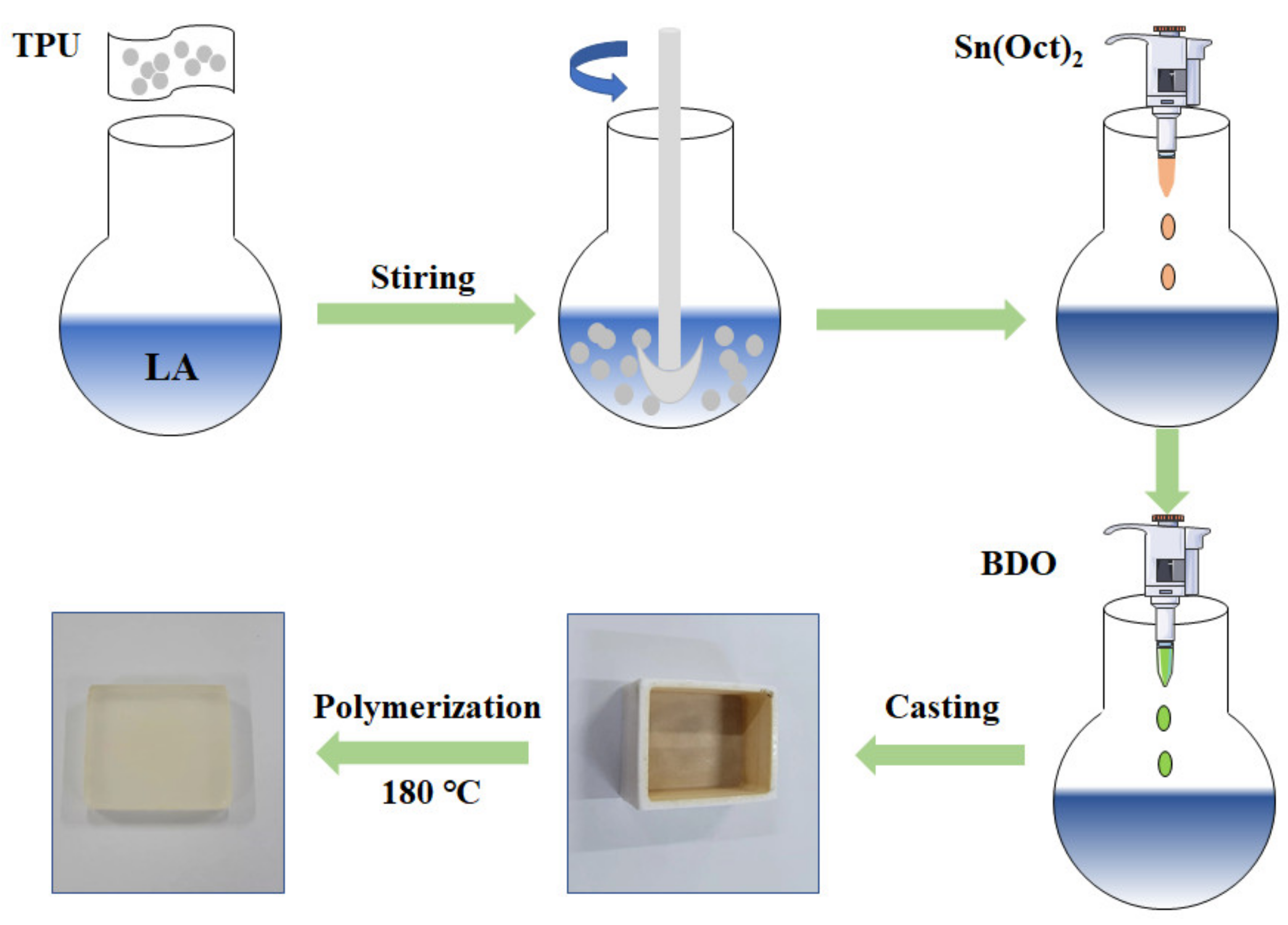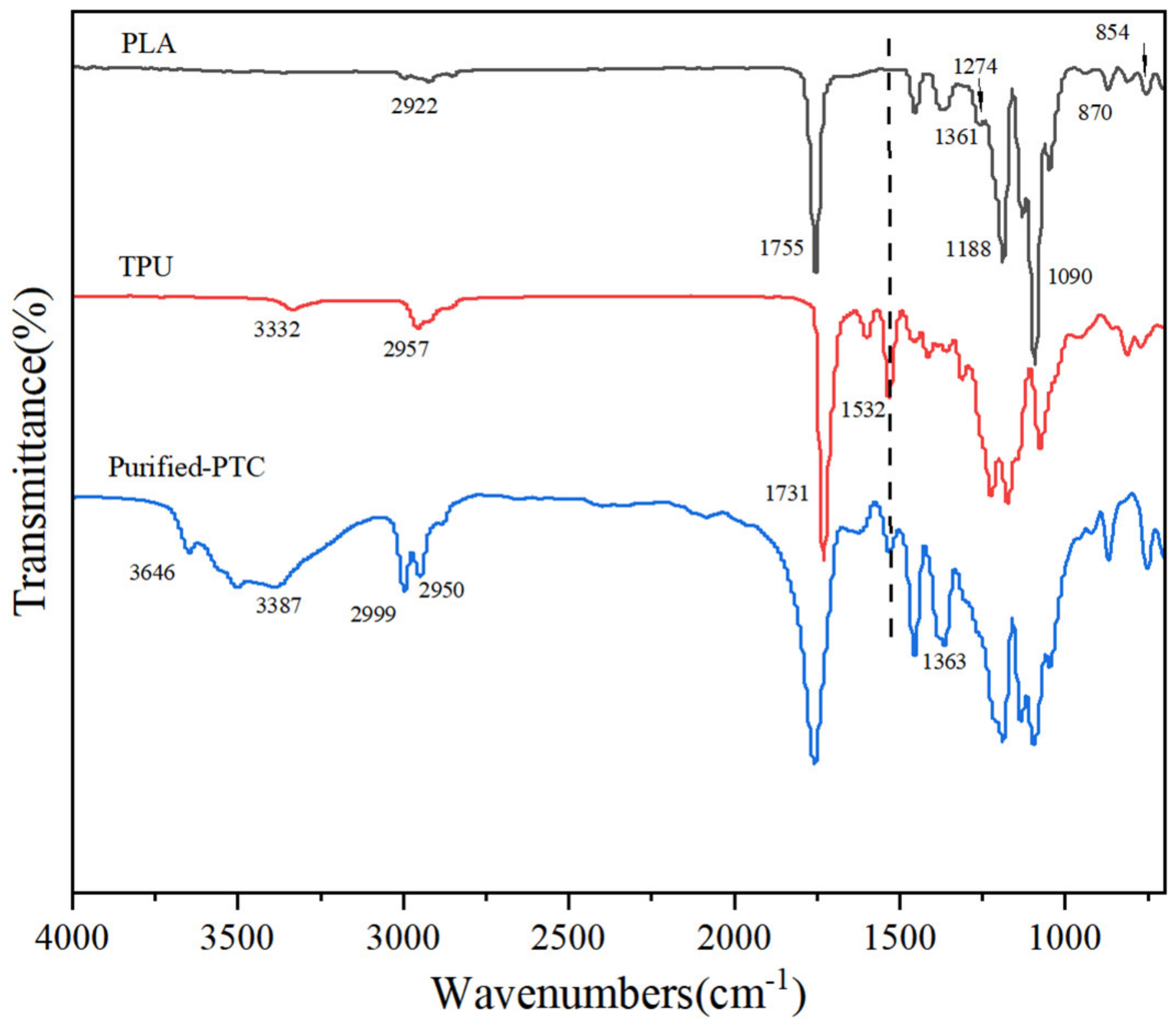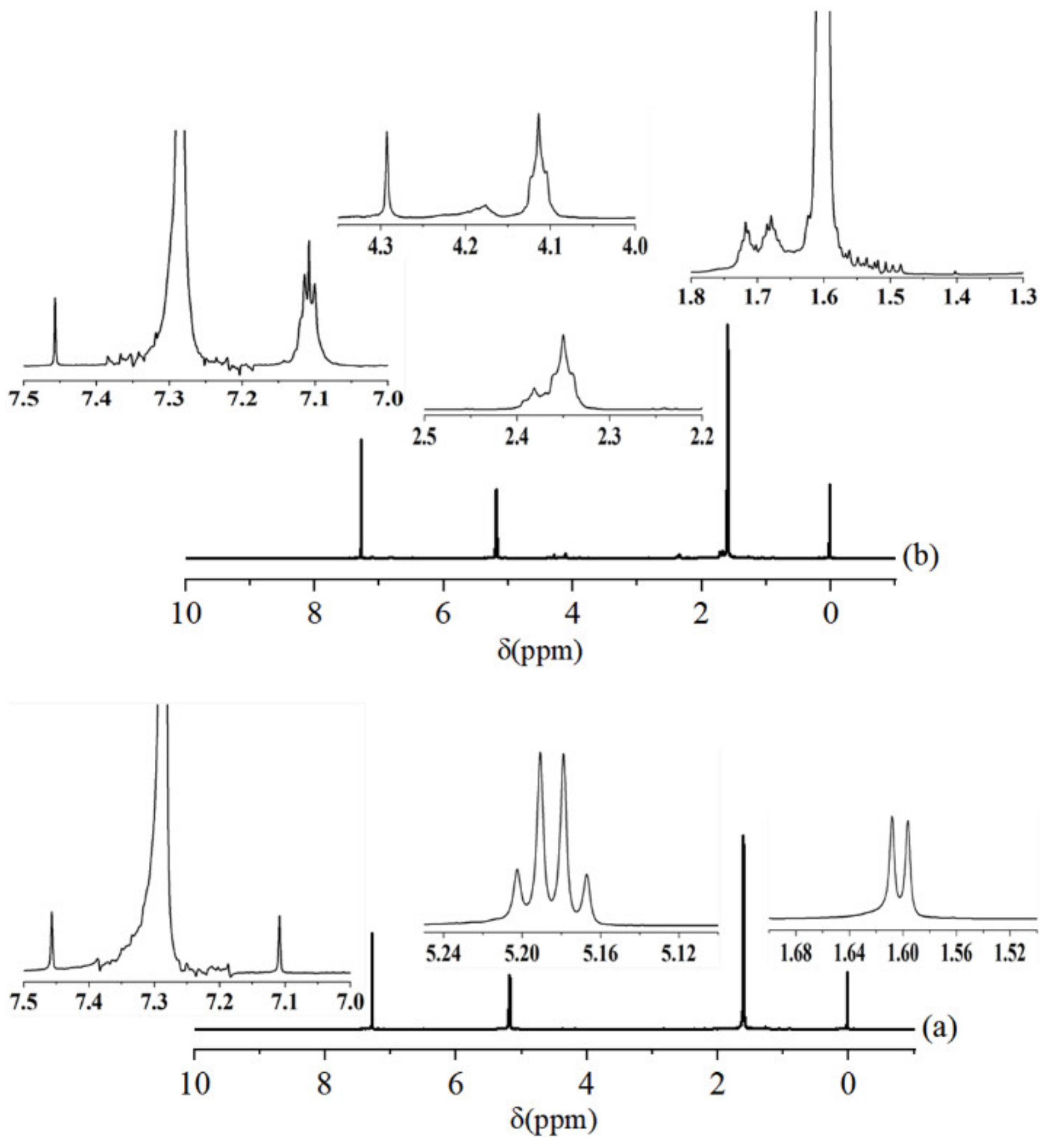Improvement of Mechanical Property for PLA/TPU Blend by Adding PLA-TPU Copolymers Prepared via In Situ Ring-Opening Polymerization
Abstract
:1. Introduction
2. Experimental
2.1. Materials
2.2. Preparation of PLA-TPU Copolymer
2.3. Preparation of PLA/TPU Blends
2.4. Purification of PTC
2.5. Characterization
3. Results and Discussion
3.1. FTIR Analysis
3.2. H-NMR Analysis
3.3. Morphology
3.4. Mechanical Property
3.5. DMA Analysis
4. Conclusions
Author Contributions
Funding
Institutional Review Board Statement
Informed Consent Statement
Data Availability Statement
Acknowledgments
Conflicts of Interest
References
- Park, S.G.; Abdal-Hay, A.; Lim, J.K. Biodegradable Poly(Lactic Acid)/Multiwalled Carbon Nanotube Nanocomposite Fabrica-tion Using Casting and Hot Press Techniques. Arch. Metall. Mater. 2015, 60, 1557–1559. [Google Scholar] [CrossRef] [Green Version]
- Li, G.; Zhao, M.; Xu, F.; Yang, B.; Li, X.; Meng, X.; Teng, L.; Sun, F.; Li, Y. Synthesis and Biological Application of Polylactic Acid. Molecules 2020, 25, 5023. [Google Scholar] [CrossRef] [PubMed]
- Mehta, G.; Mohanty, A.K.; Misra, M.; Drzal, L.T. Effect of novel sizing on the mechanical and morphological characteristics of natural fiber reinforced unsaturated polyester resin based bio-composites. J. Mater. Sci. 2004, 39, 2961–2964. [Google Scholar] [CrossRef]
- Eceiza, A.; Martin, M.D.; de la Caba, K.; Kortaberria, G.; Gabilondo, N.; Corcuera, M.A.; Mondragon, I. Thermoplastic Poly-urethane Elastomers Based On Polycarbonate Diols with Different Soft Segment Molecular Weight and Chemical Structure: Mechanical and Thermal Properties. Polym. Eng. Sci. 2008, 48, 297–306. [Google Scholar] [CrossRef]
- Xu, L.; Huang, H. Relaxation Behavior of Poly(Lactic Acid)/Poly(Butylene Succinate) Blend and a New Method for Calculating its Interfacial Tension. J. Appl. Polym. Sci. 2012, 125, E272–E277. [Google Scholar] [CrossRef]
- Nasseri, R.; Ngunjiri, R.; Moresoli, C.; Yu, A.; Yuan, Z.; Xu, C. Poly (lactic acid)/Acetylated Starch Blends: Effect of Starch Acetylation on The Material Properties. Carbohydr. Polym. 2020, 229, 115453. [Google Scholar] [CrossRef]
- Seeponkai, N.; Poolsawat, K. Physical and Mechanical Properties of Poly(Butylene Succinate) and Poly(Lactic Acid) under Landfill Conditions. Key Eng. Mater. 2020, 856, 245–252. [Google Scholar] [CrossRef]
- Goswami, J.; Bhatnagar, N.; Mohanty, S.; Ghosh, A.K. Processing and characterization of poly(lactic acid) based bioactive composites for biomedical scaffold application. Express Polym. Lett. 2013, 7, 767–777. [Google Scholar] [CrossRef]
- Lasprilla, A.J.R.; Martinez, G.A.R.; Lunelli, B.H.; Jardini, A.L.; Filho, R.M. Poly-Lactic Acid Synthesis for Application in Bio-medical Devices—A Review. Biotechnol. Adv. 2012, 30, 321–328. [Google Scholar] [CrossRef]
- Gruber, P.; Hoppe, V.; Grochowska, E.; Paleczny, J.; Junka, A.; Smolina, I.; Kurzynowski, T. Material Extrusion-Based Additive Manufacturing of Poly(Lactic Acid) Antibacterial Filaments—A Case Study of Antimicrobial Properties. Polymers 2021, 13, 4337. [Google Scholar] [CrossRef]
- Drumright, R.E.; Gruber, P.R.; Henton, D.E. Polylactic acid technology. Adv. Mater. 2000, 12, 1841–1846. [Google Scholar] [CrossRef]
- Garlotta, D. A Literature Review of Poly(Lactic Acid). J. Polym. Environ. 2001, 9, 63–84. [Google Scholar] [CrossRef]
- Baethu, A.; Pumchusak, J. Thermal and Mechanical Properties of PLA/BN/BR Ternary Composite Films. Key Eng. Mater. 2016, 707, 3–7. [Google Scholar] [CrossRef]
- Bindhu, B.; Renisha, R.; Roberts, L.; Varghese, T. Boron Nitride reinforced polylactic acid composites film for packaging: Preparation and properties. Polym. Test. 2018, 66, 172–177. [Google Scholar] [CrossRef]
- Filho, E.A.D.S.; Luna, C.B.B.; Siqueira, D.D.; Ferreira, E.D.S.B.; Araújo, E.M. Tailoring Poly(lactic acid) (PLA) Properties: Effect of the Impact Modifiers EE-g-GMA and POE-g-GMA. Polymers 2021, 14, 136. [Google Scholar] [CrossRef] [PubMed]
- Gruber, P.; Henton, D.E.; Starr, J. Polylactic Acid from Renewable Resources. Biorefineries-Industrial Processes and Products. In Biorefineries-Industrial Processes and Products: Status Quo and Future Directions; Springer: Berlin/Heidelberg, Germany, 2005; Volume 2, pp. 381–407. [Google Scholar]
- Feng, F.; Ye, L. Morphologies and mechanical properties of polylactide/thermoplastic polyurethane elastomer blends. J. Appl. Polym. Sci. 2010, 119, 2778–2783. [Google Scholar] [CrossRef]
- Jiao, L.; Huang, C.-L.; Zeng, J.-B.; Wang, Y.-Z.; Wang, X.-L. Miscibility, crystallization and mechanical properties of biodegradable blends of poly(l-lactic acid) and poly(butylene succinate-b-ethylene succinate) multiblock copolymer. Thermochim. Acta 2012, 539, 16–22. [Google Scholar] [CrossRef]
- Jin, F.-L.; Pang, Q.-Q.; Zhang, T.-Y.; Park, S.-J. Synergistic reinforcing of poly(lactic acid)-based systems by polybutylene succinate and nano-calcium carbonate. J. Ind. Eng. Chem. 2015, 32, 77–84. [Google Scholar] [CrossRef]
- Zhang, X.; Zhang, Y. Reinforcement effect of poly(butylene succinate) (PBS)-grafted cellulose nanocrystal on toughened PBS/polylactic acid blends. Carbohydr. Polym. 2016, 140, 374–382. [Google Scholar] [CrossRef]
- Nagarajan, V.; Mohanty, A.K.; Misra, M. Perspective on Polylactic Acid (PLA) Based Sustainable Materials for Durable Ap-plications: Focus on Toughness and Heat Resistance. ACS Sustain. Chem. Eng. 2016, 4, 2899–2916. [Google Scholar] [CrossRef]
- De Leon, A.C.; Chen, Q.; Palaganas, N.B.; Palaganas, J.O.; Manapat, J.; Advincula, R.C. High Performance Polymer Nano-composites for Additive Manufacturing Applications. React. Funct. Polym. 2016, 103, 141–155. [Google Scholar] [CrossRef]
- Jašo, V.; Cvetinov, M.; Rakić, S.; Petrović, Z.S. Bio-Plastics and Elastomers From Polylactic Acid/Thermoplastic Polyurethane Blends. J. Appl. Polym. Sci. 2015, 131, 547–557. [Google Scholar] [CrossRef]
- De la Rosa, S.; Mayuet, P.F.; Salgueiro, J.R.M.; Rodríguez-Parada, L. Design of Customized TPU Lattice Structures for Additive Manufacturing: Influence on the Functional Properties in Elastic Products. Polymers 2021, 13, 4341. [Google Scholar] [CrossRef] [PubMed]
- Jia, S.; Qu, J.; Chen, R.; Wu, C.; Huang, Z.; Zhai, S.; Liu, W.; Feng, Y. Effects of Thermoplastic Polyurethane On the Properties of Poly(Lactic Acid)/Organo-Montmorillonite Nanocomposites Based On Novel Vane Extruder. Polym. Eng. Sci. 2014, 54, 2292–2300. [Google Scholar] [CrossRef]
- Lis-Bartos, A.; Smieszek, A.; Frańczyk, K.; Marycz, K. Fabrication, Characterization, and Cytotoxicity of Thermoplastic Poly-urethane/Poly(lactic acid) Material Using Human Adipose Derived Mesenchymal Stromal Stem Cells (hASCs). Polymers 2018, 10, 1073. [Google Scholar] [CrossRef] [Green Version]
- Sun, H.; Hu, J.; Bai, X.; Zheng, Z.; Feng, Z.; Ning, N.; Zhang, L.; Tian, M. Largely improved toughness of poly(lactic acid) by unique electrospun fiber network structure of thermoplastic polyurethane. Polym. Test. 2017, 64, 250–253. [Google Scholar] [CrossRef]
- Wang, J.; Zhang, Y.; Sun, W.; Chu, S.; Chen, T.; Sun, A.; Guo, J.; Xu, G. Morphology Evolutions and Mechanical Properties of In Situ Fibrillar Polylactic Acid/Thermoplastic Polyurethane Blends Fabricated by Fused Deposition Modeling. Macromol. Mater. Eng. 2019, 304, 1900107. [Google Scholar] [CrossRef]
- Lai, S.M.; Lan, Y.C. Shape Memory Properties of Melt-Blended Polylactic Acid (PLA)/thermoplastic Polyurethane (TPU) Bio-Based Blends. J. Polym. Res. 2013, 20, 140. [Google Scholar] [CrossRef]
- Jing, X.; Mi, H.-Y.; Peng, X.-F.; Turng, L.-S. The morphology, properties, and shape memory behavior of polylactic acid/thermoplastic polyurethane blends. Polym. Eng. Sci. 2014, 55, 70–80. [Google Scholar] [CrossRef]
- Sharifah, I.S.S.; Adnan, M.D.A.; Nor Khairusshima, M.K.; Shaffiar, N.M.; Buys, Y.F. Effect of Thermoplastic Polyurethane (TPU) On the Thermal and Mechanical Properties of Polylactic Acid (PLA)/curcumin Blends. IOP conference series. Mater. Sci. Eng. C 2018, 290, 12081. [Google Scholar]
- Han, J.; Huang, H. Preparation and Characterization of Biodegradable Polylactide/Thermoplastic Polyurethane Elastomer Blends. J. Appl. Polym. Sci. 2011, 120, 3217–3223. [Google Scholar] [CrossRef]
- Yu, F.; Huang, H. Simultaneously Toughening and Reinforcing Poly (lactic acid)/Thermoplastic Polyurethane Blend via En-hancing Interfacial Adhesion by Hydrophobic Silica Nanoparticles. Polym. Test. 2015, 45, 107–113. [Google Scholar] [CrossRef]
- Dogan, S.K.; Reyes, E.A.; Rastogi, S.; Ozkoc, G. Reactive compatibilization of PLA/TPU blends with a diisocyanate. J. Appl. Polym. Sci. 2013, 131, 40251. [Google Scholar] [CrossRef]
- He, Y.; Zeng, J.; Liu, G.; Li, Q.; Wang, Y. Super-Tough Poly(L-Lactide)/Crosslinked Polyurethane Blends with Tunable Impact Toughness. RSC Adv. 2014, 4, 12857–12866. [Google Scholar] [CrossRef]
- Lin, W.; He, Y.; Qu, J.P. Super-Tough and Highly-Ductile Poly(L-lactic acid)/Thermoplastic Polyurethane/Epoxide-Containing Ethylene Copolymer Blends Prepared by Reactive Blending. Macromol. Mater. Eng. 2019, 304, 1900020. [Google Scholar] [CrossRef]
- Zhang, H.; Kang, B.; Chen, L.; Lu, X. Enhancing Toughness of Poly (Lactic acid)/Thermoplastic Polyurethane Blends Via In-creasing Interface Compatibility by Polyurethane Elastomer Prepolymer and its Toughening Mechanism. Polym. Test. 2020, 87, 106521. [Google Scholar] [CrossRef]
- Mo, X.-Z.; Wei, F.-X.; Tan, D.-F.; Pang, J.-Y.; Lan, C.-B. The compatibilization of PLA-g-TPU graft copolymer on polylactide/thermoplastic polyurethane blends. J. Polym. Res. 2020, 27, 33. [Google Scholar] [CrossRef]
- Kaynak, C.; Meyva, Y. Use of maleic anhydride compatibilization to improve toughness and other properties of polylactide blended with thermoplastic elastomers. Polym. Adv. Technol. 2014, 25, 1622–1632. [Google Scholar] [CrossRef]
- Chafran, L.S.; Campos, J.M.C.; Santos, J.S.; Sales, M.J.A.; Dias, S.C.L.; Dias, J.A. Synthesis of Poly(Lactic Acid) by Heteroge-neous Acid Catalysis From D,L-Lactic Acid. J. Polym. Res. 2016, 23, 23–107. [Google Scholar] [CrossRef]
- Hou, L.-L.; Liu, H.-Z.; Yang, G.-S. A novel approach to the preparation of thermoplastic polyurethane elastomer and polyamide 6 blends byin situ anionic ring-opening polymerization of ɛ-caprolactam. Polym. Int. 2006, 55, 643–649. [Google Scholar] [CrossRef]
- Nofar, M.; Mohammadi, M.; Carreau, P.J. Effect of TPU hard segment content on the rheological and mechanical properties of PLA/TPU blends. J. Appl. Polym. Sci. 2020, 137, 49387. [Google Scholar] [CrossRef]
- Mahmud, M.S.; Buys, Y.F.; Anuar, H.; Sopyan, I. Miscibility, Morphology and Mechanical Properties of Compatibilized Pol-ylactic Acid/Thermoplastic Polyurethane Blends. Mater. Today Proc. 2019, 17, 778–786. [Google Scholar] [CrossRef]
- Bernardes, G.P.; Rosa Luiz, N.; Santana, R.M.C.; Camargo Forte, M.M. Influence of the Morphology and Viscoelasticity On the Thermomechanical Properties of Poly(Lactic Acid)/Thermoplastic Polyurethane Blends Compatibilized with Ethylene-Ester Copolymer. J. Appl. Polym. Sci. 2020, 137, 48926. [Google Scholar] [CrossRef]






| Sample | PLA/wt.% | TPU/wt.% | PTC/wt.% |
|---|---|---|---|
| PLA | 100 | 0 | 0 |
| PT1 | 99 | 1 | 0 |
| PT3 | 97 | 3 | 0 |
| PT5 | 95 | 5 | 0 |
| PT10 | 90 | 10 | 0 |
| PT10/PTC2.5 | 90 | 10 | 2.5 |
| PT10/PTC5 | 90 | 10 | 5 |
| PT10/PTC7.5 | 90 | 10 | 7.5 |
| PT10/PTC10 | 90 | 10 | 10 |
| Sample | Tensile Strength (MPa) | Young’s Modulus (MPa) | Impact Strength (kJ/m2) |
|---|---|---|---|
| PLA | 65.2 ± 1.0 | 5567 ± 101 | 16.5 ± 2.1 |
| PT1 | 66.3 ± 2.2 | 5459 ± 206 | 16.9 ± 3.3 |
| PT3 | 63.2 ± 2.6 | 5121 ± 246 | 19.2 ± 1.2 |
| PT5 | 61.5 ± 2.0 | 4963 ± 102 | 19.4 ± 1.1 |
| PT10 | 58.6 ± 3.3 | 4748 ± 200 | 21.2 ± 1.6 |
| PT10/PTC2.5 | 66.7 ± 1.7 | 5308 ± 303 | 20.9 ± 2.8 |
| PT10/PTC5 | 66.1 ± 2.0 | 5180 ± 204 | 27.8 ± 2.0 |
| PT10/PTC7.5 | 61.6 ± 2.5 | 5205 ± 100 | 23.4 ± 2.5 |
| PT10/PTC10 | 61.4 ± 3.1 | 5306 ± 261 | 21.0 ± 3.0 |
Publisher’s Note: MDPI stays neutral with regard to jurisdictional claims in published maps and institutional affiliations. |
© 2022 by the authors. Licensee MDPI, Basel, Switzerland. This article is an open access article distributed under the terms and conditions of the Creative Commons Attribution (CC BY) license (https://creativecommons.org/licenses/by/4.0/).
Share and Cite
Fang, H.; Zhang, L.; Chen, A.; Wu, F. Improvement of Mechanical Property for PLA/TPU Blend by Adding PLA-TPU Copolymers Prepared via In Situ Ring-Opening Polymerization. Polymers 2022, 14, 1530. https://doi.org/10.3390/polym14081530
Fang H, Zhang L, Chen A, Wu F. Improvement of Mechanical Property for PLA/TPU Blend by Adding PLA-TPU Copolymers Prepared via In Situ Ring-Opening Polymerization. Polymers. 2022; 14(8):1530. https://doi.org/10.3390/polym14081530
Chicago/Turabian StyleFang, Hui, Lingjie Zhang, Anlin Chen, and Fangjuan Wu. 2022. "Improvement of Mechanical Property for PLA/TPU Blend by Adding PLA-TPU Copolymers Prepared via In Situ Ring-Opening Polymerization" Polymers 14, no. 8: 1530. https://doi.org/10.3390/polym14081530
APA StyleFang, H., Zhang, L., Chen, A., & Wu, F. (2022). Improvement of Mechanical Property for PLA/TPU Blend by Adding PLA-TPU Copolymers Prepared via In Situ Ring-Opening Polymerization. Polymers, 14(8), 1530. https://doi.org/10.3390/polym14081530






